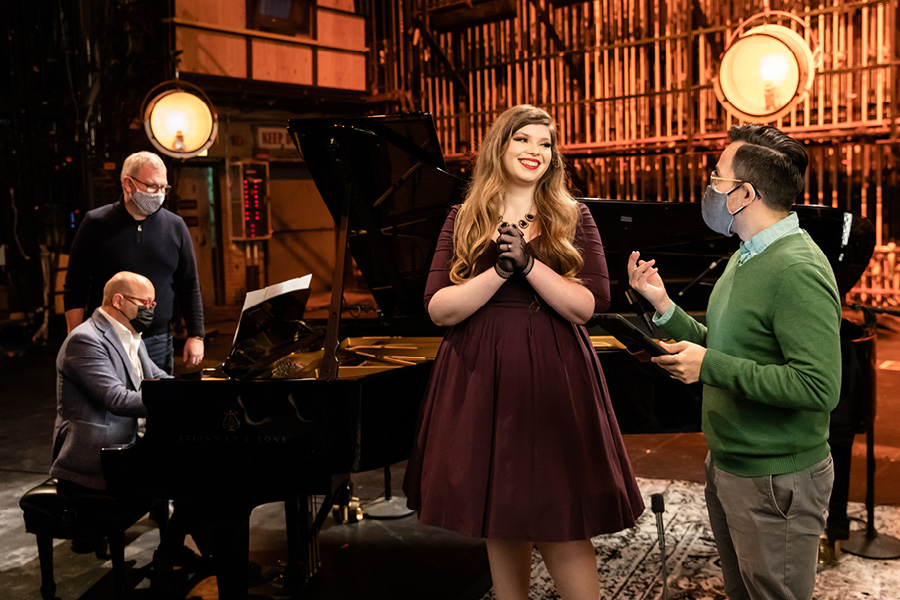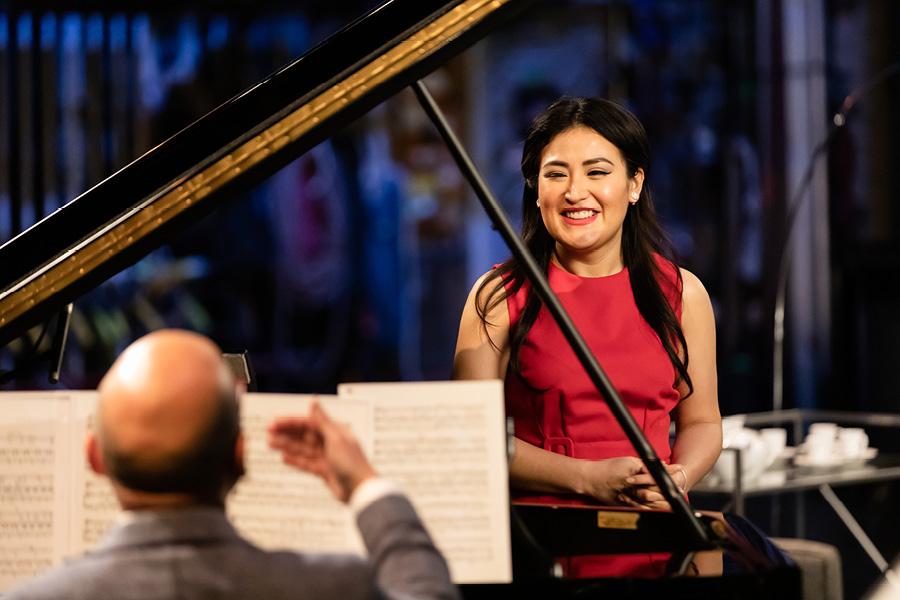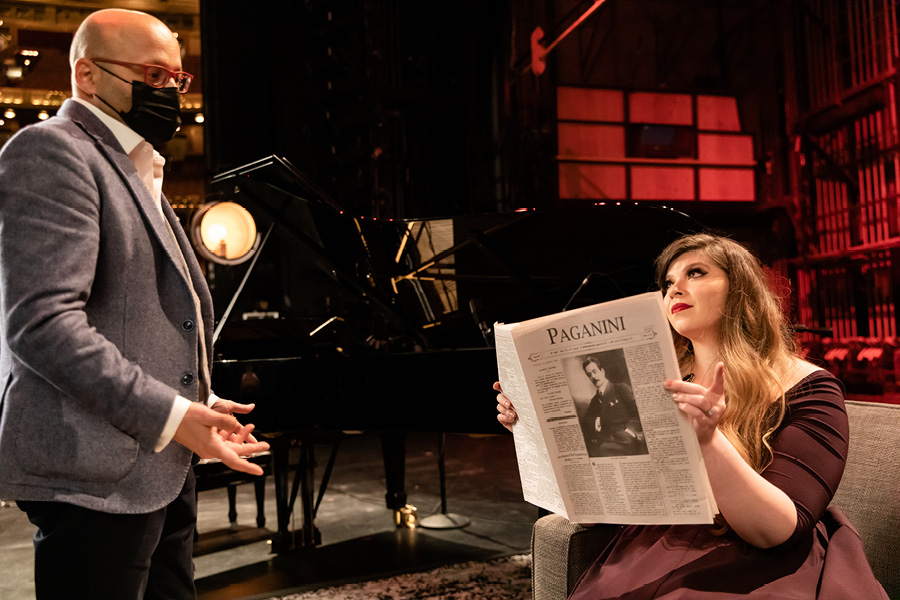May 06, 2020
Lights, Cameras, Action!
Conductor, of course. Collaborative pianist, sure. Cinematic conceptualizer...perché no?
Without a doubt, Enrique Mazzola is a multitasking maestro.
When he came up with the idea of exploring Italian songs with the Ryan Opera Center Ensemble for the Sole e Amore performance that will premiere online on Sunday, February 21, Mazzola recalls, “I didn’t want to make a traditional, typical recital, with the singer in front of the piano just singing.” He also wanted to focus on freestanding songs meant to be sung in an intimate setting, rather than arias extracted from operas.
“Behind every piece of music there is dramaturgy,” he explains. “In opera it's very obvious; you see the dramaturgy on the stage. It’s less obvious in a Mahler symphony or in a song. I always try to find the story behind every piece of music.
“For Sole e Amore, I imagined a cinematographic concert in which we would tell some stories,” Mazzola continues. “I envisioned that with the camera we would have dark scenes when the subject is extremely dramatic or sad, we would have a different nuance of light for melancholy, and still different for joy. I wanted to work with the faces of the singers in the film we made. It was a really unique experience—it was the first time in my life creating music and every ten minutes going behind the camera to see if the camera reflected my imagination.”

First-year Ryan Opera Center baritone Leroy Davis preparing to film his Sole e Amore repertoire.
Mazzola worked closely to share his vision with Matthew Ozawa, the director of Sole e Amore. Since 2007 Ozawa has directed or assistant-directed over 20 productions for Lyric and Lyric Unlimited, most recently the thrilling Donizetti triple-header The Three Queens starring Sondra Radvanovsky in Lyric’s 2019/20 Season. Ozawa also currently serves as interim director of Lyric Unlimited.
The video crew’s monitor showed all three camera views, Mazzola recalls of the late-January recording sessions onstage at the Lyric Opera House (with full safety protocols followed, of course). “I really liked to check the screen, discussing with Matthew, the filmmaker, and our lighting designer the type of atmosphere I wanted us to create around each singer,” he says. With his knowledge of each song’s trajectory, Mazzola suggested “when we could have a wide cut to see the piano and singer, or when the camera should only focus on the singer. Very often the piano finishes a song, so the melody transitions from the voice to the pianist. We have a story to tell also from the camera, with movement that’s very natural.”
Mazzola envisioned the set as “the living room of a musician’s family, We can imagine it’s like a loft, with a piano next to the sofa, and everything happens in that space.” Sole e Amore consists of “many different micro-stories with two strong links. The first one is the exploration of the meaning of love in 20 or more different ways, and of course the other very strong connection is how Italians sing the idea of love in many different colors and ways. The camera has to reinforce this idea of different colors of love.”

Behind the scenes direction featuring first-year Ryan Opera Center mezzo-soprano Katherine DeYoung chatting with director Matthew Ozawa, with Enrique Mazzola at the piano. Ryan Opera Center Musicc Director Craig Terry looks on.
During the week of recording, Mazzola discovered the similarities between conducting and filmmaking. “Like a conductor, a filmmaker needs to have a global view of the idea, and exactly like a conductor, the filmmaker has to underline the ability of exploring the value of every single detail. This is exactly what I do when I open an opera score. I have to be able to imagine the big picture of the opera and at the same time I have to request that my colleagues—the musicians in the orchestra, the chorus, the soloists—be able to articulate all the details. All the details are like a puzzle—the small pieces of a large picture.”
While he admires a certain iconic Italian filmmaker, “I cannot say that our Sole e Amore experience was done in Fellini’s style!” Mazzola says with a laugh. “Still, we have to respect that we want to tell a story and that we are onstage.”

Enrique Mazzola coaching first-year Ryan Opera Center soprano Denis Vélez in between takes.
A fascinating bit of backstory to this project is that Mazzola hadn’t played piano publicly in more than two decades—so he was working “outside the box” of conducting in more ways than one. What made him decide to perform collaboratively again? He was drawn to the idea that it “would connect me so closely to our artists of the Ryan Opera Center. When I play the piano, I’m participating with their own breathing, their own phrasing. I didn’t want to be an exterior actor in this production, as sometimes a conductor is, because we need to see things globally when we conduct. I wanted to create music in the moment. That’s why I played the piano.” He didn’t know any of the repertoire in advance; “I really had to learn the pieces, and go back to the discipline of practicing everyday, which is a beautiful discipline in a period of lockdown, of inactivity. I found something very beautiful in creating this ‘moment’ of self-discipline.”
Although the song titles may not be widely familiar, Mazzola is quick to note that many of their melodies will be instantly recognizable, because they “are ideas that the composers developed into arias in their operas,” he notes. “For opera lovers, Sole e Amore will be a real treasure hunt! They will recognize a piece of I puritani, of La rondine, of La bohème, and this will be fun for them!”
For those who don’t know anything about opera, Mazzola adds, “it’s a beautiful first step to enter into the romantic Italian world of singing, passion, and love. And of course for those who are listening to this kind of music for the first time, I invite them to take the second step, which is to see how we put on stage this style of singing, passion, and love.”

Enrique Mazzola and Katherine DeYoung working with a fun prop for one of DeYoung's songs.
Photo credit: Kyle Flubacker
